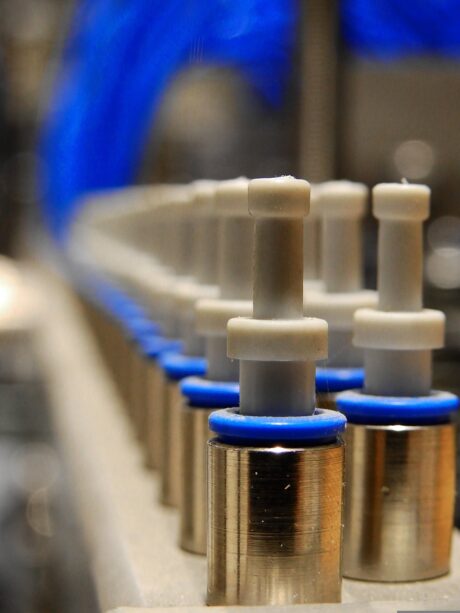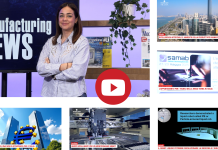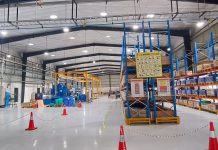IIoT is growing with Smart Pneumatics. The advent of IoT, with its factory application, has allowed introducing measuring through the collection of data in each field of the smart factory. Sensors, applied on existing machines, in retrofitting operations or embedded into the most recent technological solutions, allow in fact collecting punctual information in real time of each protagonist component of the manufacturing process of a factory, since the early machining phases to the warehouse management. The information processing, the drawing up of reports and the integration into decisional processes allow processing production strategies, redefining work models, identifying predictive maintenance courses as integration of the preventive one, to full benefit of production quality and saving. Particularly challenging issue in a period, like the one we are living, which looks with particular attention also at energy consumptions and the use of components that reduce maintenance, permitting the measurability of the processes into which they are integrated. Among them, stands out pneumatics that, due to operation and efficiency characteristics, is increasingly taking hold as strategic solution for automation, enriching its qualities with the distinguishing characters of the Industrial internet of Things and therefore turning into Smart Pneumatics: connectivity, sensors, processing systems and ergonomic data publication.
What is at stake
Pneumatics is one of the most diffused applications in the field of industrial automation, where many devices based on the use of air as energy source to operate drives are used. The energy that derives from compressed air, in fact, filtered and purified, is converted by actuators that so allow operating various mobile devices equipping an automated line or whatever device contained in it. Pneumatics is, in short, the controlled release of compressed air, to produce a linear or rotary motion of a device. Low management costs and systems’ growing capability of withstanding corrosion have increased the application ambits already widely consolidated in very different sectors, which range from the freight transport to railway where, for instance, pneumatics is used for doors and suspensions, to packaging, where it is particularly exploited for pick&place solutions and, in general, in industrial automation lines, where it is necessary to grasp, to tighten and to displace objects.
IIoT is growing with Smart Pneumatics: market trends
The smart pneumatics is one of the new IIoT frontiers, with growth forecasts that, in the 2021-2026 period, reach the 6.94% CAGR. A rise driven by the affirmation of the OEE – Overall Equipment Effectiveness – paradigm, which sees in the data collection in real time and in their processing one of the bases for the measurement of corporate processes’ efficiency.

Besides, on a global scale, the overall market will reach 5.5 billion dollars within 2026, with a significant growth in volume from 3.76 billions in 2020. This despite the sudden slowdown determined by the pandemic crisis, which has significantly hindered the demand for automation, clearing up the cards of the market. Smart pneumatics is one of the bases of the predictive maintenance, which allows reducing by 12% on average the repairs scheduled according to conventional schemes, on the whole decreasing costs by 30% and reducing by 70% less the number of unexpected machine downtimes. Estimates affirm in fact that 80% of the enterprises specialized in industrial manufacturing are assessing solutions connected with the IIoT to reach a better energy efficiency, to increase the production capacity and to redefine the quality concept, thanks to more precise actuators, able to modulate their actions and then to guide more efficacious processes at all levels. The markets where a more dynamic growth is foreseen in the concerned period are Asia and Pacific, thanks to a variety of investments in energy ambit and in sustainable solutions that meet the requirements of satisfying the needs of a population in constant demographic growth. The United States are instead the protagonists of the most extended market for this device typology, with the complicity of the market’s high automation degree. Finally, the sector is ruled by a strict array of players that, in the first five places by market penetration, see Emerson Electric, Festo, Thomson Industries, Metso Corporation and Parker Hannifin.
Diagnostics and pneumatics
Among the advantages of the processing of real time data of smart pneumatic devices, maintenance and diagnostics stand out, as they are the priorities of OEM players. The target is a predictive maintenance that allows overcoming the manual controls carried out by a staff who applies pre-established schemes, sometimes anticipating unnecessary interventions where emergencies and unexpected events can lead to risks of machine downtimes and production stops. Operations that, although standardized, do not assure efficiency levels that can be compared to those offered by the digital, which can rely on real-time data, statistic operation processing and dynamic reporting constantly updated to the state-of-the-art. Furthermore, Embedded IoT and 5G connectivity are real enabling factors of the Industrial Internet of Things, because they represent the basis on which the whole digitalization course of the manufacturing in factory develops, where smart pneumatics plays a protagonist role.
Innovation trend: sustainability as strong point
The issues that qualify pneumatics include sustainability, due to the foreseeability of operation cycles and to the processing of data collected by embedded sensors during the activity. Calculating, for instance, what maintenance interventions are mandatory after 10,000 cycles allows using efficient devices in terms of energy profile and operation, so avoiding anticipated replacements and malfunctions. The flow control, for instance, is a key factor in the processing of energy saving strategies, combined with the double regulation of the circuit pressure, which for pneumatics is an efficiency channel able to increase the pressure inside the actuator, then applying a lower pressure level in the return phase. A further example of how pneumatics allows processing energy saving strategies is the flow control guaranteed by embedded systems, which permits to reduce consumptions in case of inactivity, by regulating the pressure to minimal configuration parameters. Finally leaks, very common in pneumatic systems, need constant controls to identify the dispersion points in the air, to measure their impact on the production and to define the costs of inefficiency on the pneumatic system. A problem that is solved by monitoring devices integrated into the IoT, connected with edge computing solutions that, detecting a variety of parameters – from vibrations to speed and dispersion pressure – allow processing the optimal solution to decrease the consumptions and the energy costs of the plant itself, availing themselves, in the most advanced cases, of machine learning solutions.
Case history astride agriculture and industry
At the end of the survey, it is interesting to point out some emblematic cases of applications where the smart pneumatics has played a determinant role also in sectors that are apparently distant from the automation world, too. It is the case of the seed bags filling by means of silos equipped with systems featuring two-position opening and closing, which does not allow measuring the flow, compelling operators to the filling or emptying of the lacking or excess material. Therefore, an inaccurate system, but also influenced by a series of further technical difficulties like, for instance, clogging. Therefore, they have identified a smart solution based on the retrofitting of existing plants, which has allowed providing the site with IIoT embedded pneumatic components. The technical upgrade has then led to an innovative solution based on a system that allows varying the opening and closing positions in gradual and customized manner, so assuring a regulated measurable flow of seeds in packages.
The industrial applicative context of smart pneumatics integrated into an agile manufacturing course is more coherent with standard IoT ambits. The solution satisfies the requirements of OEE improvement with the use of a single motion control system, which allows the management of different operations like the integration of complex motions, variable positions and condition monitoring, so making pneumatics independent from mechanics, to reach high flexibility levels of production. The solution’s quality is defined by two components. On one hand, the app for the collection and the analysis of data by sensors, which the operator can receive on a mobile device, and on the other hand the control panel that enables an overview of the system and the evaluation of parameters connected with efficiency, maintenance processes and manufacturing performances. Indispensable tools for the management, to improve the OEE and to integrate their evaluations into maintenance plans pre-configured according to the operation of the historical file, mapped by the embedded IoT system and made available for the various corporate functions for the definition of inclusive and transversal strategies for the different requirements.



